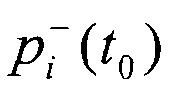FIELD: medicine.
SUBSTANCE: invention relates to the field of medicine, in particular to a method for predicting the individual risk of obesity in a person for different periods of life. Method consists in the fact that the content of chemical elements that are dangerous for the development of obesity is determined in human biological media; surveys are conducted; the initial value of the probability p (to) of the occurrence of obesity in a person at the current age of a person to at the time of the survey is calculated; for each quantitative diagnostic indicator, except for HDL and a quality indicator, the function fi of its deviations from the physiological norm is found; each specified diagnostic indicator is given the following weighting factor ϕI; initial value of the probability p (t0a) of occurrence of obesity for the current age of the person is calculated; using an iterative procedure, the individual risk of obesity in a person is predicted with a time step of 1 day; in the examined person, the prognostic indicators in the blood and urine are determined for the current age; their level is compared to the physiological norm; for the prognostic indicator, the probability of  exceeding or the probability of
exceeding or the probability of  decreasing it relative to the physiological norm is set; general probability
decreasing it relative to the physiological norm is set; general probability  of excess over the norm for the prognostic indicator, or the general probability
of excess over the norm for the prognostic indicator, or the general probability  of decline relative to the norm at the age of a person t is set; overall probability of obesity in a person is calculated and the risk of obesity in a person is predicted by the magnitude of individual risk.
of decline relative to the norm at the age of a person t is set; overall probability of obesity in a person is calculated and the risk of obesity in a person is predicted by the magnitude of individual risk.
EFFECT: creating an informative and evidence-based method for predicting the individual risk of obesity in a person living under conditions of environmental pollution by aromatic hydrocarbons and metals.
1 cl, 2 dwg, 1 ex, 8 tbl
Authors
Dates
2019-01-16—Published
2018-02-22—Filed